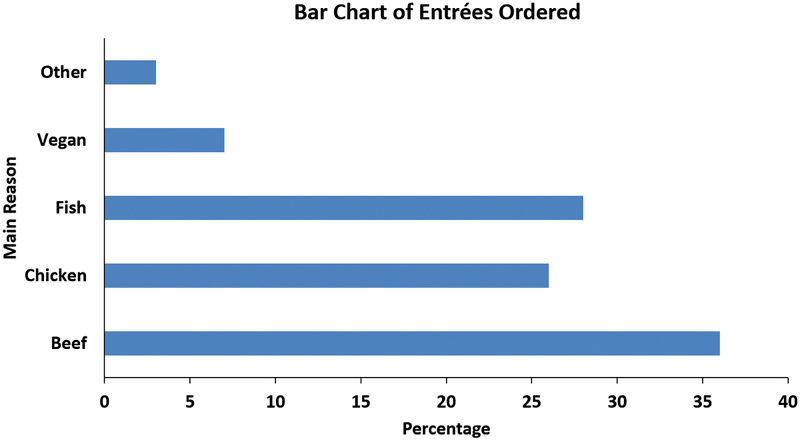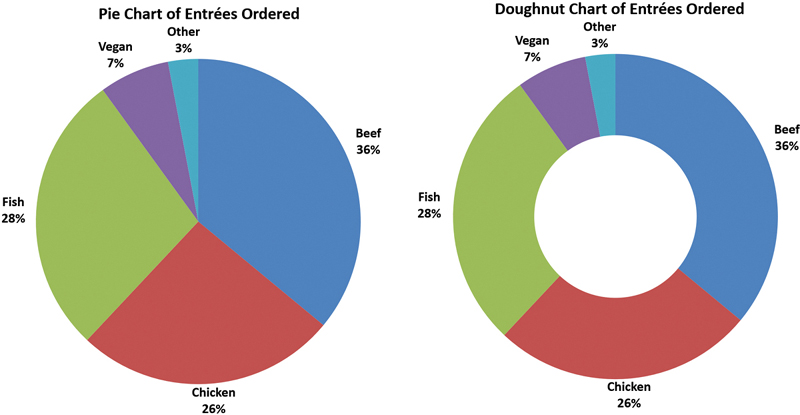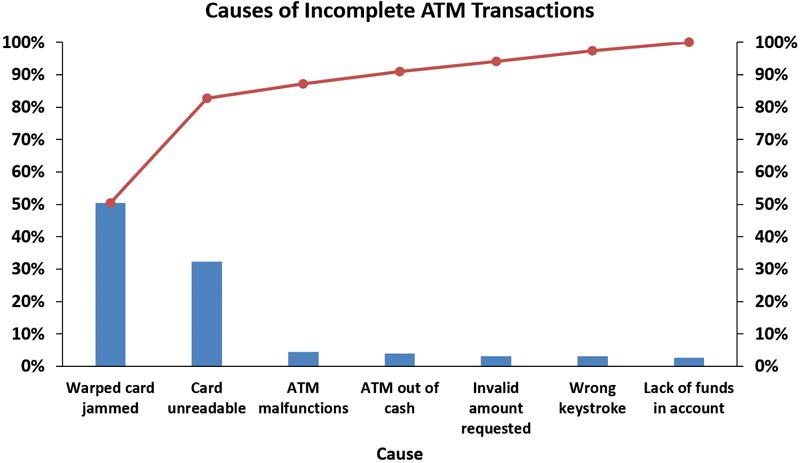Presenting Data Using Tables and Charts
- 2.1 Presenting Categorical Variables
- 2.2 Presenting Numerical Variables
- 2.3 “Bad” Charts
- One-Minute Summary
- Test Yourself
- References
2.1 Presenting Categorical Variables
2.2 Presenting Numerical Variables
2.3 “Bad” Charts
One-Minute Summary
Test Yourself
Tables and charts are ways of summarizing categorical and numerical variables that can help you present information effectively. In this chapter, you will learn the appropriate types of tables and charts to use for each type of variable.
2.1 Presenting Categorical Variables
You present a categorical variable by first sorting values according to the categories of the variable. Then you place the count, amount, or percentage (part of the whole) of each category into a summary table or into one of several types of charts.
The Summary Table
>Concept A two-column table in which category names are listed in the first column and the counts, amounts, or percentages of values are listed in a second column. Sometimes, additional columns present the same data in more than one way (for example, as counts and percentages).
Example A restaurant owner records the entrées ordered by guests during the Friday-to-Sunday weekend period. The data recorded can be presented using a summary table.
Entrée Ordered |
Percentage |
|---|---|
Beef |
36 |
Chicken |
26 |
Fish |
28 |
Vegan |
7 |
Other |
3 |
Interpretation Summary tables enable you to see the big picture about a set of data. In this example, you can conclude that most customers will order beef, chicken, or fish. Very few will order either vegan or other entrées.
The Bar Chart
Concept A chart containing rectangles (“bars”) in which the length of each bar represents the count, amount, or percentage of responses of one category.
Example The data of the summary table that the previous concept uses can be visualized using a percentage bar chart.
Interpretation A bar chart better presents the point that beef entrée is the single largest category of entrée ordered. For most people, scanning a bar chart is easier than scanning a column of numbers in which the numbers are unordered, as they are in the previous summary table.
The Pie Chart and the Doughnut Chart
Concept Pie: A circle chart in which wedge-shaped areas—pie slices—represent the count, amount, or percentage of each category, and the entire circle (“pie”) represents the total.
Doughnut: A circle chart in which parts of the circumference represent the count, amount, or percentage of each category, and the entire circumference represents the total.
Example The following pie and doughnut charts visualize the summary table data that the two preceding concepts use.
Interpretation A pie chart or a doughnut chart enables you to see how the various categories contribute to the whole. In the example charts, you can see that chicken and fish entrées make up about half of all entrées ordered and that beef is the entrée most ordered.
In recent years, doughnut charts have become preferred over pie charts. The area of pie “slices” can be misperceived, making the pie slice seem larger or smaller than the percentage of the whole that the slice represents. In contrast, doughnut charts focus attention on the lengths of each arc, which are easier to compare and accurately reflect the percentage of the whole.
Note that pie and doughnut charts do not enable you to as easily compare categories as a bar chart does. On the other hand, bar charts are less useful for understanding parts of a whole. The restaurant owner who recorded the entrée selections likely will want to compare categories and understand how each category contributes to the whole. Therefore, that person might use both a bar chart and a pie or doughnut chart to visualize the collected data.
The Pareto Chart
Concept A special type of bar chart that presents the counts, amounts, or percentages of the categories, in descending order left to right, and also contains a superimposed plotted line that represents a running cumulative percentage.
Example Causes of Incomplete ATM Transactions
Cause |
Frequency |
Percentage |
|---|---|---|
ATM malfunctions |
32 |
4.42% |
ATM out of cash |
28 |
3.87% |
Invalid amount requested |
23 |
3.18% |
Lack of funds in account |
19 |
2.62% |
Card unreadable |
234 |
32.32% |
Warped card jammed |
365 |
50.41% |
Wrong keystroke |
23 |
3.18% |
Total |
724 |
100.00% |
Source: Data extracted from A. Bhalla, “Don’t Misuse the Pareto Principle,” Six Sigma Forum Magazine, May 2009, pp. 15–18.
This Pareto chart uses the data of the table that immediately precedes it to highlight the causes of incomplete ATM transactions.
Interpretation When you have many categories, a Pareto chart enables you to focus on the most important categories by visually separating the vital few from the trivial many categories. For the incomplete ATM transactions data, the Pareto chart shows that two categories, warped card jammed and card unreadable, account for more than 80% of all defects and that those two categories combined with the ATM malfunctions and ATM out of cash categories account for more than 90% of all defects.
Two-Way Table
Concept A table that presents the counts or percentages of responses for two categorical variables. In a two-way table, the categories of one of the variables form the rows of the table, while the categories of the second variable form the columns. The last row of a two-way table contains column totals, and the last column of such a table contains the row totals. Two-way tables are also known as cross-classification or cross-tabulation tables.
Examples This two-way table tallies entrées ordered by guests during the Friday-to-Sunday weekend period by sex.
|
|
Sex |
|
|
|
|
Female |
Male |
Total |
|
Beef |
64 |
80 |
144 |
|
Chicken |
53 |
51 |
104 |
Entrée Ordered |
Fish |
72 |
40 |
112 |
|
Vegan |
8 |
20 |
28 |
|
Other |
3 |
9 |
12 |
|
Total |
200 |
200 |
400 |
Two-way tables can be formatted to show grand total percentages or row or column percentages.
Grand Total Percentages Table
|
|
Sex |
|
|
|
|
Female |
Male |
Total |
|
Beef |
16.00% |
20.00% |
36.00% |
|
Chicken |
13.25% |
12.75% |
26.00% |
Entrée Ordered |
Fish |
18.00% |
10.00% |
28.00% |
|
Vegan |
2.00% |
5.00% |
7.00% |
|
Other |
0.75% |
2.25% |
3.00% |
|
Total |
50.00% |
50.00% |
100.00% |
Row Percentages Table
|
|
Sex |
|
|
|
|
Female |
Male |
Total |
|
Beef |
44.44% |
55.56% |
100.00% |
|
Chicken |
50.96% |
49.04% |
100.00% |
Entrée Ordered |
Fish |
64.29% |
35.71% |
100.00% |
|
Vegan |
28.57% |
71.43% |
100.00% |
|
Other |
25.00% |
75.00% |
100.00% |
|
Total |
50.00% |
50.00% |
100.00% |
Column Percentages Table
|
|
Sex |
|
|
|
|
Female |
Male |
Total |
|
Beef |
32.00% |
40.00% |
36.00% |
|
Chicken |
26.50% |
25.50% |
26.00% |
Entrée Ordered |
Fish |
36.00% |
20.00% |
28.00% |
|
Vegan |
4.00% |
10.00% |
7.00% |
|
Other |
1.50% |
4.50% |
3.00% |
|
Total |
100.00% |
100.00% |
100.00% |
Interpretation The simplest two-way table contains a row variable that has two categories and a column variable that has two categories. This creates a table that has two rows and two columns in its inner part (see the table on the next page). Each inner cell represents the count or percentage of a pairing, or cross-classifying, of categories from each variable.
|
|
Column Variable |
||
Row Variable |
|
First Column Category |
Second Column Category |
Total |
First Row Category |
Count or percentage for first row and first column categories |
Count or percentage for first row and second column categories |
Total for first row category |
|
Second Row Category |
Count or percentage for second row and first column categories |
Count or percentage for second row and second column categories |
Total for second row category |
|
Total |
Total for first column category |
Total for second column category |
Overall total |
|
Two-way tables reveal the combination of values that occurs most often in data. In the example, the tables reveal that males are more likely to order beef than females and that females are more likely to order fish.
PivotTables create worksheet summary tables from sample data and provide a good way of creating two-way tables from sample data. Advanced Technique AT1 in Appendix E discusses how to create such tables.



